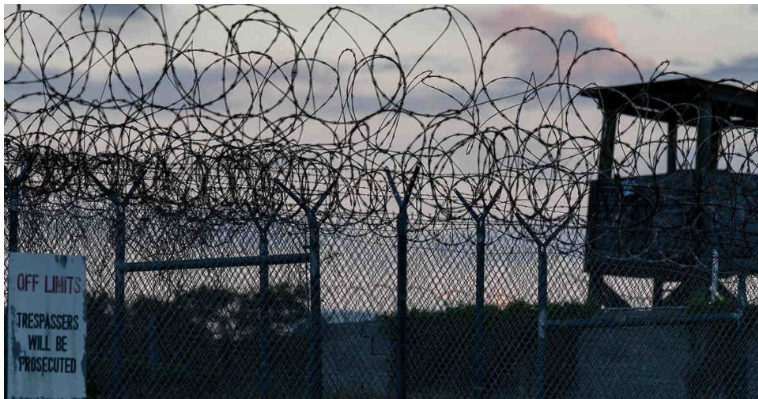CommentsSURVIVAL FOR THE WORLD OF TOMORROW-Over the last year, the country has been shocked by reports of the inhumane treatment of children and families in immigrant detention. Now, the Trump administration appears to be increasing the scope and severity of its immigrant detention scheme by potentially detaining immigrants at Guantanamo Bay.
News broke last week that the Defense Department awarded a $23 million dollar contract to construct a “Contingency Mass Migration Complex” at the Guantanamo Bay Naval Station with capacity to detain 13,000 people and built to last “a minimum of 50 years.” In April, we also learned that the Department of Homeland Security considered sending migrant children to an old “dormitory facility” at Guantanamo.
I’ve been to Guantanamo. I visited in 2015 as an observer of the military commission proceedings, staying in a dusty tent barrack for a week. With a stunning landscape and ugly history, it is full of contradictions—like selling Mickey Mouse-Guantanamo Bay souvenirs in the gift shop, mere miles from where men have languished in detention without fair trials, or even charges, for more than a decade. I left with a pit in my stomach, unsettled by this deeply strange place. It has been a site of torture, where our country’s leaders have long embraced or tolerated injustice. It is certainly no place for children.
No child should grow up in jail, no matter where it is located. Studies show that kids in immigration detention suffer emotionally and physically, with traumatizing conditions including “sleep[ing] on cement floors,” “insufficient foods and water,” and “extremely cold temperatures.”
But sending kids to Guantanamo is uniquely dangerous. It’s easy to imagine the Defense Department restricting or totally denying journalists, lawyers, and human rights groups access to monitor or investigate, enabling officials to commit abuses with little risk of being discovered. Members of Congress, who’ve already been refused access to visit detention facilities on the mainland, may have little or no ability to conduct effective oversight at Guantanamo. Kids sent to Guantanamo might be put in expedited removal proceedings (deported without the opportunity see a judge) that we’ve explained “invite, and guarantee, error.” The Trump administration might argue they have no rights at Guantanamo at all.
Bottom line: there’s a serious risk the government could deny immigrants sent to Guantanamo a real opportunity to seek protection from return to persecution or torture -- contradicting Congress’ intent, and their rights under US and international law.
History tells us that politicians might excuse or willfully turn a blind eye to abuses that happen at Guantanamo. For decades, multiple administrations have tried to treat it as a legal black hole, a place where the rights of non-citizens can be violated, and bedrock principles of the U.S. legal system ignored. In 2002, the government sent hundreds of men there and tried to create a “battle lab” for experimental abuses, many of which amounted to torture and other forms of cruel, inhuman and degrading treatment.
Despite Supreme Court decisions making clear that Guantanamo is in fact not a legal black hole, more than a decade later politicians like Senator Tom Cotton (R-Ark.) celebrate it as a place beyond the law. “As far as I’m concerned, every last one of [the detainees] can rot in Hell, but as long as they don’t do that they can rot in Guantanamo Bay,” Cotton told the Senate in a 2015 hearing. I was there, and I remember the room going silent at his words -- but no senator condemned them. Despite years of advocacy by the ACLU and other groups, Guantanamo remains a place where the government can engage in unlawful conduct, outside of the public eye.
Guantanamo’s longer history helps explain why. In the 1990s, the U.S. Coast Guard intercepted tens of thousands of people from Haiti and Cuba fleeing violence and human rights violations at sea. More than 45,000 people were taken to Guantanamo and held in tent cities. In a striking parallel to today, hundreds of children were separated from their families, kept in inhumane conditions, and authorities had trouble keeping track of people in family units. Thousands of Haitian nationals were returned to Haiti despite having credible fears of persecution, forcing parents to leave their children behind.
By 1995 there were still more than 200 unaccompanied kids from Haiti languishing at Guantanamo, despite having relatives and other sponsors in the U.S. ready to welcome them. “The kids are isolated and fearful,” columnist Bob Herbert wrote. “They live in tents that tend to leak when it rains. They are ill-clothed (some do not even have shoes) and receive inadequate medical attention. Many of the youngsters are depressed and some have attempted suicide.”
Congress should not let the Trump administration repeat this terrible history. It should reject the White House’s $3.7 billion request for custody operations, and demand the administration consider alternatives to detention that have proven to be more cost-effective and humane.
There’s a horrific American tradition of holding people at Guantanamo unlawfully. It’s long past time we bring it to an end and close Guantanamo for good.
(Nauren Shah is Amnesty International USA's Director of Security and Human Rights. This piece originally appeared in Common Dreams.) Prepped for CityWatch by Linda Abrams.
















